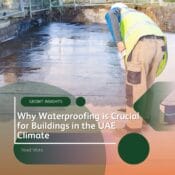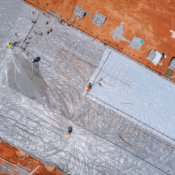
How to Maintain Your Waterproofing System for Longevity
Waterproofing systems protect buildings from water damage, mold growth, and structural deterioration. In regions with extreme weather conditions, such as the UAE, maintaining these systems is crucial for ensuring their longevity and effectiveness. Proper maintenance not only extends the life of waterproofing solutions but also saves property owners from costly repairs and renovations. This blog will provide a comprehensive guide on how to maintain your waterproofing system effectively.
Understanding Waterproofing Systems
Before diving into maintenance strategies, it’s essential to understand the different types of waterproofing systems commonly used:
- Liquid Applied Membranes (LAMs): These are applied as a liquid and cure to form a seamless, flexible barrier against water.
- Sheet Membranes: These are pre-manufactured membranes that are rolled out and adhered to surfaces.
- Cementitious Waterproofing: A mixture of cement and other additives that creates a waterproof barrier on surfaces.
- Bituminous Coatings: These are made from asphalt and are often used for roofs and below-grade applications.
Each type of waterproofing system has its unique maintenance requirements, but some general practices apply to all.
Regular Inspections
Conduct Regular Inspections: Schedule routine inspections at least once a year, and more frequently after heavy rainfall or significant weather events. Look for signs of wear and tear, such as:
- Cracks or peeling in the waterproofing layer
- Discoloration or stains on walls and ceilings
- Mold or mildew growth
- Water pooling in areas where it shouldn’t
By identifying issues early, you can address them before they escalate into more significant problems.
Clean Gutters and Drains
Maintain Clear Gutters and Drains: Clogged gutters and drains can lead to water accumulation, increasing the risk of leaks and water damage. Regularly clean out debris from gutters and downspouts to ensure proper drainage.
- Tip: Consider installing gutter guards to minimize debris accumulation.
Address Plumbing Issues Promptly
Fix Leaks and Plumbing Issues Immediately: Plumbing leaks can compromise your waterproofing system. Regularly check for leaks in pipes, faucets, and fixtures. If you notice any leaks, address them promptly to prevent water from infiltrating your walls and foundation.
Maintain Proper Grading and Slope
Ensure Proper Grading: The land surrounding your property should slope away from the foundation. This prevents water from pooling near the building, which can lead to seepage. If you notice that water is pooling near your foundation, consider regrading the landscape or adding drainage solutions.
Reapply Protective Coatings
Reapply Protective Coatings: Over time, protective coatings on waterproofing membranes may wear off. Depending on the type of waterproofing system, you may need to reapply these coatings every few years.
- Tip: Follow the manufacturer’s guidelines for reapplication and maintenance schedules.
Document Maintenance Activities
Keep a Maintenance Log: Document all inspections, maintenance activities, and repairs. This log will help you track the condition of your waterproofing system over time and provide valuable information for future maintenance.
Engage Professional Services
Hire Professionals for Comprehensive Inspections: While homeowners can perform some maintenance tasks, engaging professionals for thorough evaluations and complex repairs is advisable. Professionals have the expertise to identify underlying issues that may not be visible to the untrained eye.
- Tip: Look for certified waterproofing contractors with good reviews and a solid reputation in the industry.
Seasonal Maintenance Tips
Adapt Maintenance to Seasonal Changes: In regions like the UAE, where weather conditions can vary significantly, it's essential to adapt your maintenance strategies seasonally. For example:
- Before the Rainy Season: Inspect and clean gutters, downspouts, and drainage systems. Ensure that all waterproofing membranes are intact and functioning correctly.
- After Heavy Rains: Conduct a thorough inspection for leaks or signs of water damage. Check for pooling water around the foundation and address any drainage issues.
Addressing Common Problems
Identify and Resolve Common Waterproofing Issues: Some common issues that can arise in waterproofing systems include:
- Cracking: This can occur due to temperature fluctuations or structural movement. Small cracks can often be sealed with appropriate sealants, but larger cracks may require professional assessment.
- Blistering: This is often caused by trapped moisture beneath the membrane. If you notice blistering, it’s essential to investigate and repair the underlying cause.
- Ponding Water: Areas where water tends to pool can lead to membrane failure. Ensure proper drainage and consider installing additional drainage solutions if necessary.
Maintaining your waterproofing system is essential for ensuring its longevity and effectiveness. By conducting regular inspections, keeping gutters and drains clear, addressing plumbing issues promptly, and engaging professional services when necessary, you can protect your property from water damage and extend the life of your waterproofing solutions.
Investing time and effort into proper maintenance will not only safeguard your property but also save you from costly repairs in the long run. Remember, a proactive approach to waterproofing maintenance is key to preserving the integrity of your home or building.



